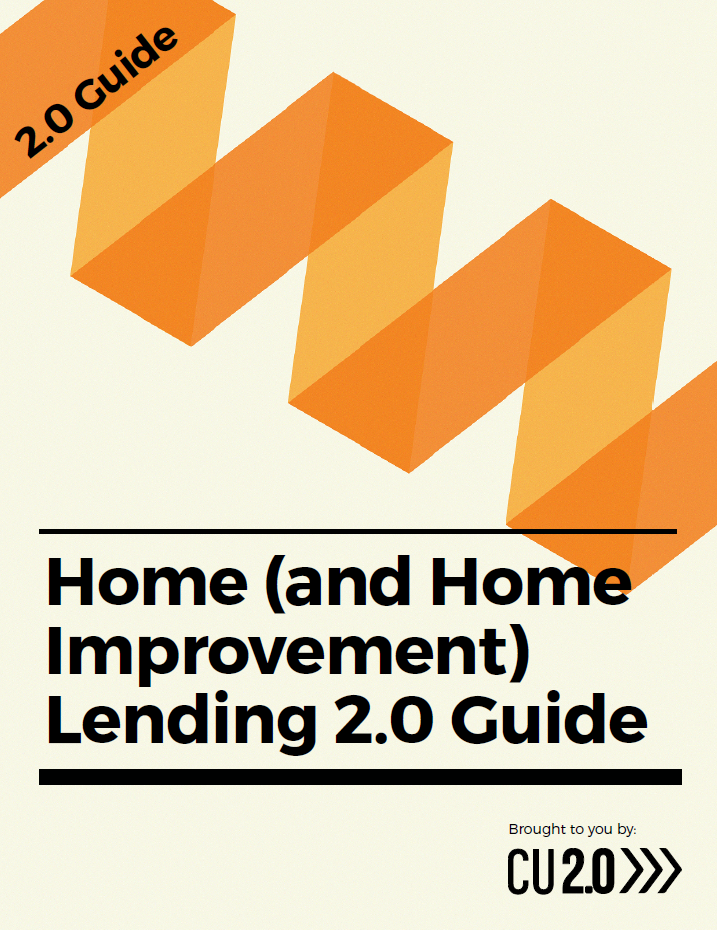This Home Lending 2.0 Guide is intended to show the state of home lending in the U.S. It’ll offer some insight about lending trends and the role that fintechs play in driving those trends. It’ll also explore challenges facing traditional home lenders.
Additionally, this guide will dive into borrower expectations and preferences—especially in light of the red-hot housing market during COVID-19 and the potential correction beginning in 2022.
Important to note is the rise of fintech and marketplace lenders now addressing various home loan needs. In the last few years, most national banks have followed trends set by these alternative lenders by launching their own digital solutions (often powered by outside vendors). Today, credit unions can do the same by partnering with or leveraging fintechs to provide faster and more varied lending options.
Ultimately, this guide will help you find fintechs and CUSOs that can help you transform your home and home improvement lending strategy. If you want your home lending products to meet your members’ needs and compete with fintechs, the companies in this list will help you reimagine your home lending ability.
Check out our new downloadable Credit Union Provider Guides here!
Or download this full guide here:
Home Lending Trends and Analysis
- A slow housing market.
Gone are the days of 2021 when the housing market boomed. Back then, interest rates plummeted, home prices rose, and buyers snapped them up faster than sellers could put them on the market. Often, houses sold for more than asking price within hours of hitting the market.
Yet, despite a few rate decreases in late 2024, the housing market remains almost painfully slow. With the economic uncertainty of post-election policy and a conservative approach to dropping rates, the housing market is unlikely to heat up quickly.
Solutions that improve buyer/seller mobility (such as fully-digital processes and “buy before you sell” services) may be key.
- Home lending is a digital-first market. Other lenders are rapidly losing market share.
The mortgage and home improvement borrowing experience has been painful, historically. Hours-long applications and document hunts followed by periods of limited visibility about status and timelines were the status quo.
Then, Quicken Loans debuted Rocket Mortgage in 2015, and it allowed borrowers to complete applications in ~10 minutes. In less than 2 years, they were the leading mortgage provider in the country.
Today, the top home loan providers are digital. And, while the chart certainly shows a bias for national providers, it’s worth noting that all the listed national providers below now offer digital-first home loans to remain competitive against Rocket Mortgage.
Credit unions absolutely must leverage fintech solution to provide competitive home loans. Anything less at this stage is, by definition, substandard.
- Digital lending processes are faster and more efficient than paper-based ones.
It’s not just convenience that drives borrowers toward digital lenders. Shortly after Rocket Mortgage took the mantle of #1 mortgage lender, the Federal Reserve Bank of New York published a study that found that fintechs reduced average mortgage close time by 9 days and average refinance time by 12 days.
Importantly, the report showed that fintech lenders managed this feat while controlling for variables and without targeting marginal buyers or increasing default rates.
Especially in hot housing markets, the additional time to close from traditional lenders puts their borrowers at a competitive disadvantage. The conclusion of the study determined that digital and fintech lending has improved the efficiency and fairness of home lending. That final finding is paramount, as it suggests that credit unions will significantly improve their member experience and financial health by providing digital fintech-powered home lending solutions.
- “Buy before you sell” is a growing buyer need.
Slow markets mean that people can’t always sell their home as quickly as they’d like to buy one. This creates issues, such as buyers juggling mortgages and buyers making contingent offers.
Studies have shown that non-contingent offers are 4 times more likely to win the sale.
Furthermore, contingent offers typically pay 3–11% more per purchase. Buy before you sell services eliminate this pain point for buyers whose purchase of a new home relies (at least in part) on the successful sale of their old home.
- Don’t miss out on home improvement lending.
Significantly on the rise—especially with people “trapped” in mortgages with pandemic-era interest rates—are homeowners who want more house but don’t want to move. For these lucky/unlucky folks, and for many others, the best route to the best house is through home improvement lending.
Furthermore, as old HVAC systems fail and buyers park more EVs in their driveways, people increasingly look toward green upgrades in their home improvement strategy. Offering financing options for eco-friendly updates such as heat pumps, EV charging stations, and insulation present new opportunities for loan growth.
If you’re looking to expand your loan portfolio, home improvement lending might be seriously untapped potential. Check out partners like RenoFi and Halitra to see how you can help members upgrade their existing homes. You may find that home improvement lending is a great memberization engine, too.
Evaluation Strategies
There are a lot of home lending solutions out there, and it might be hard to find the right one for your credit union. If you’re deciding between a few options, these questions and considerations may help you narrow down the field to find the best fit.
Type of lending solution
There are so many home lending solutions—is this the one you need? Sure, it’s an obvious question, but it’s worth making sure the company does what you need it to do.
Member relationship
Will the solution lead to a deeper relationship with your members, or will it ultimately disintermediate you?
Members affected
Which members are most likely to benefit from this solution? Does it benefit low- and middle-income members are well as high-income earners?
Digital experience
Is the solution fully digital, partially digital, or mostly manual? Furthermore, how digital is the solution? Technically, emailing documents back and forth is digital, but it’s not a streamlined digital process.
Ease of use
How much effort will your members have to put in for the solution to be successful? How much effort will your staff have to put in?
Security and compliance
Does the solution meet or exceed your security and compliance requirements? Is it well positioned to meet emerging ones as well?
Industry-specific features
Does the product come with functions tailored to credit unions? Does the vendor have a deep understanding of credit union needs?
Integrations
Will the solution integrate with your tech stack? Will you have to create manual connections, or is it already set up to work with your core, etc.?
Reporting and analytics
Do you need reporting and analytics capabilities with the home lending product? Can they be basic, or will you want extensive information and analysis?
Support and training
Does the provider offer training? How much? Will they help you market the solution, or will that be entirely your responsibility?
Fintech Ratings
Rating Methodology
CU 2.0’s rating methodology attempts to score fintechs based on the 4 most important factors for credit unions:
- Income statement: (1) Non-interest income and/or deposits, (2) interest income, (3) both
- Balance sheet: (1) Deposits, (2) loans, (3) both
- Member impact: By members affected: (1) 1–33%, (2) 33 – 66%, (3) 66–100% and/or memberization
- Employee impact: (1) Improves workflows, (2) automates some, (3) automates a lot
We score each category above on a scale of 1 to 3 according to the scale above, with scores of 0 indicating that the solution has no known impact. Additionally, in some guides, providers will have very similar scores.
Our ratings don’t necessarily correlate to quality, nor do they suggest which solution is best for you. Fintechs with higher scores aren’t automatically better, or a better fit, for your credit union and members. Additionally, please note that these ratings are estimations based on our understanding of the product or service. We may have left out solutions that either don’t partner with credit unions, or whose partnership terms may be predatory. (In some cases, when we cannot confirm a vendor’s partnership terms, we may err on the side of caution.)
Trusted solutions are highlighted with an asterisk—these are fintechs that CU 2.0 has vetted personally.
Fintech Lending Vendor Guide
| Fintech | Description | Income | Balance | Member | Employee | |
| ACES Quality Management | ACES Quality Management helps lenders review and audit loans more efficiently. | 2 | 2 | 1 | 2 | |
| Blend | Blend is a digital mortgage, loan, and banking platform with extensive data partnerships | 2 | 2 | 1 | 2 | |
| Calque* Learn more | Calque allows buyers to use the equity in their existing home to purchase a new one. | 2 | 2 | 3 | 2 | |
| Cloudvirga | Cloudvirga is a digital mortgage platform that uses automation to decrease time and costs. | 2 | 2 | 1 | 2 | |
| Figure | Figure is a blockchain- and crypto-friendly mortgage and lending platform for borrowers and lenders. | 2 | 2 | 1 | 2 | |
| FinLocker | FinLocker helps consumers prepare for mortgages and connects them with agents and lenders. | 2 | 2 | 3 | 1 | |
| Floify | Floify helps lenders with a digital dashboard and automation in the mortgage process. | 2 | 2 | 1 | 1 | |
| Halitra* Learn more | Halitra increases loan volume by topping up property loans with eco-friendly add-ons. | 2 | 2 | 1 | 2 | |
| Hometap | Hometap allows homeowners to tap into their home equity to access a loan alternative. | 2 | 2 | 1 | 1 | |
| Housetable* Learn more | Housetable allows lenders to offer fully-digital home improvement loans. | 2 | 2 | 1 | 2 | |
| Lendsmart | Lendsmart accelerates and streamlines the lending process for credit unions with AI and automation. | 2 | 2 | 1 | 2 | |
| LoanNEX | LoanNEX offers a residential mortgage marketplace for buyers and helps originators automate workflows within it. | 2 | 2 | 3 | 2 | |
| LoanStar Technologies | LoanStar Technologies allows lenders to diversify lending with point-of-sale and home improvement loans. | 2 | 2 | 3 | 2 | |
| Momnt | Momnt allows lenders to offer automated point-of-sale loans through partnered businesses. | 2 | 2 | 3 | 2 | |
| NestReady | NestReady keeps early-stage buyers in the credit union with their white-label app. | 2 | 2 | 1 | 2 | |
| Point | Point lets homeowners make Home Equity Investments, HELOCs, and SEED investments. | 2 | 2 | 1 | 1 | |
| Revival Homes | Revival Homes streamlines the permitting, lending, and construction process for California ADUs. | 2 | 2 | 1 | 1 | |
| RenoFi* Learn more | RenoFi lets lenders offer home improvement loans against the borrower’s post-renovation home value. | 2 | 2 | 3 | 2 | |
| Rocket Mortgage* Learn more | Rocket Mortgage is the largest mortgage lender in the country and may have partnership terms for small- to midsize credit unions. | 2 | 2 | 1 | 2 | |
| Roostify | Roostify’s point-of-sale platform helps lenders close loans faster and improve margins. | 2 | 2 | 1 | 2 | |
| The Servion Group | The Servion Group helps credit unions with mortgage, commercial, real estate, title, and other loans. | 2 | 2 | 1 | 2 | |
| Staircase* | Staircase seamlessly connects all mortgage lending technologies on a single platform. | 2 | 2 | 1 | 2 | |
| Teslar | Teslar helps lenders with audit and compliance. | 2 | 2 | 1 | 2 | |
| Total Expert* Learn more | Total Expert offers credit union- and mortgage-specific CRM and marketing automation. | 2 | 2 | 3 | 2 | |
| Turnkey Lender | Turnkey Lender offers an AI-powered loan origination and lending platform. | 2 | 2 | 1 | 2 | |
| Wolters Kluwer | Wolters Kluwer offers a variety of lending and compliance solutions for lenders. | 2 | 2 | 1 | 2 | |
Please note that these ratings may be updated as we include more data and more complex variables. The ratings are estimations only—your credit union could see a different level of impact than listed in this guide.
Did we miss a fintech? Please let us know at info@cu-2.com
Recommendations
Choosing the right partners to leverage fintech lending capabilities and efficiencies will depend on your goals, budget, timeline, and other factors. CU 2.0 can help in the following ways:
- Join our Fintech Call Program. In quarterly 30-minute calls, we’ll discuss in depth new and innovative fintech solutions that fit your credit union’s needs. We can also help you review other solutions you’re looking at.
- Ask for an introduction. We maintain relationships with most or all of the vendors rated above. We would be happy to give you a warm introduction to any we can on the list.
- Book a consultation. CU 2.0 offers technology and fintech consultations and reviews to identify best-fit solutions for your credit union.
Get all of our downloadable 2.0 Guides here.
Or download the full credit union Home and Home Improvement Lending Provider Guide here:




